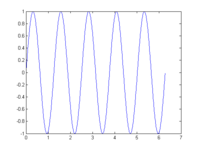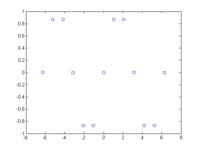(→Periodic Signals Revisited) |
(→Periodic Signals Revisited) |
||
| Line 4: | Line 4: | ||
Found here: http://cobweb.ecn.purdue.edu/~mboutin/ECE301/Index.html | Found here: http://cobweb.ecn.purdue.edu/~mboutin/ECE301/Index.html | ||
| − | [[Image:sin5t_ECE301Fall2008mboutin.png|200px| | + | I chose to modify the signal a bit and make it y = sin(5t). |
| + | |||
| + | [[Image:sin5t_ECE301Fall2008mboutin.png|200px|left]] | ||
| + | |||
| + | If you plot the signal in DT sampling at delta = .5Hz you get a periodic signal as follows: | ||
| + | |||
| + | [[Image:sin5tper_ECE301Fall2008mboutin.png|200px|left]] | ||
Revision as of 09:37, 11 September 2008
Periodic Signals Revisited
The function chosen (by randomly clicking a name) from hw1 is y=sin(t). Found here: http://cobweb.ecn.purdue.edu/~mboutin/ECE301/Index.html
I chose to modify the signal a bit and make it y = sin(5t).
If you plot the signal in DT sampling at delta = .5Hz you get a periodic signal as follows:



